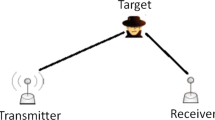Abstract
We consider a bistatic radar sensor network that consists of multiple separated radar transmitters and radar receivers, which are deployed to detect targets among a set of points of interest. Any transmitter-receiver pair with the same frequency forms a bistatic radar. In contrast to the disk-based sensing model in a traditional sensor network, the detection probability of a bistatic radar depends on both locations of the transmitter and receiver. Given the radar transmitters’ locations and illuminating frequencies, we study the problem of joint radar receiver placement and frequency selection to maximize the target detection probability. We first study the case where there is a set of candidate locations to place the radar receivers, and propose a simple algorithm with approximation ratio at least 0.63. We then consider the case where there is no constraint for radar receivers’ locations, and develop an approximation algorithm which is provably close to optimal. Finally, the numerical results are presented to show the efficacy of our algorithms.








Similar content being viewed by others
Notes
Since the radar transmitters need much power to illuminate radar signals, their locations depend heavily on the power supplying system, and thus there is little freedom to place the radar transmitters.
In this subsection, receiver \(r\) is a general term which is used just to illustrate how to divide the area and does not refer to any specific receiver.
Note that the locations of the PoIs and transmitters are excluded for the placement of receivers.
Note that there is no placement error for the case with constrained receiver locations.
References
Griffiths, H. (2010). Multistatic, MIMO and networked Radar: The future of radar sensors. In Proceedings of 7th Eurpean radar conference.
Willis, N.-J. (2005). Bistatic radar. Raleigh: SciTech Publishing.
Manjunath, B., Zhang, J., Suppappola, A. P., & Morrell, D. (2009). Sensor scheduling with waveform design for dynamic target tracking using MIMO radar. In Proceedings of asilomar conference on signals, systems and computers, Pacific Grove, CA.
Baker, C.-J., & Hume, A.-L. (2003). Netted radar sensing. IEEE Aerospace and Electronic Systems Magazine, 18, 3–6.
Bartoletti, S., Conti, S., & Giorgetti, A. (2010). Analysis of UWB radar sensor networks. In Proceedings of IEEE international conference on communications (ICC).
Gong, X., Zhang, J., Cochran, D., & Xing, K. (2013). Barrier coverage in bistatic radar sensor networks: Cassini oval sensing and optimal placement. In Proceedings of ACM Mobihoc (pp. 49–58).
Tang, L., Gong, X., Wu, J., & Zhang, J. (2013). Target detection in bistatic radar networks: node placement and repeated security game. IEEE Transactions on Wirelss Communications, 12(3), 1279–1289.
Chakrabarty, K., Iyengar, S., Qi, H., & Cho, E. (2002). Grid coverage for surveillance and target location in distributed sensor networks. IEEE Transactions on Computers, 51(12), 1448–1453.
Cheng, X., Du, D., Wang, L., & Xu, B. (2008). Relay sensor placement in wireless sensor networks. ACM Wireless Networks, 14(3), 347–355.
Lin, F., & Chiu, P. L. (2005). A near-optimal sensor placement algorithm to achieve complete coverage/discrimination in sensor networks. IEEE Communications Letters, 9(1), 43–45.
Mohsen, E., Lata, N., & Jaroslav, O. (2013). On multi-round sensor deployment for barrier coverage. In Proceedings of IEEE international conference on mobile ad-hoc and sensor systems.
Clouqueur, T., Phipatanasuphorn, V., Ramanathan, P., & Saluja, K. K. (2002). Sensor deployment strategy for target detection. In Proceedings of ACM international workshop wireless sensor networks and applications.
Xing, G., Tan, R., Liu, B., Wang, J., Jia, X., & Yi, C. (2009). Data fusion improves the coverage of wireless sensor networks. In Proceedings of ACM MobiCom.
Wang, W., Srinivasan, V., Chua, K., & Wang, B. (2007). Energy-efficient coverage for target detection in wireless sensor networks. In Proceedings of IEEE IPSN.
Nemhauser, G., Wolsey, L., & Fisher, M. (1978). An analysis of the approximations for maximizing submodular set functions. Mathematical Programming, 14, 265–294.
Yang, D., Fang, X., & Xue, G. (2011). ESPN: Efficient server placement in probabilistic networks with budget constraint. In Proceedings of IEEE INFOCOM.
Roy, S., Pucha, H., Zhang, Z., Hu, Y. C., & Qiu, L. (2009). On the placement of infrastructure overlay nodes. IEEE/ACM Transactions on Networking, 17(4), 1298–1311.
Welzl, E. (1991). Smallest enclosing disks. Lecture Notes in Computer Science, 555, 359–370.
Shi, Y., & Hou, Y. T. (2008). Theoretical results on base station movement problem for sensor network. In Proceedings of IEEE INFOCOM.
Author information
Authors and Affiliations
Corresponding author
Rights and permissions
About this article
Cite this article
Tang, L., Chen, H., Lan, S. et al. Approximation Algorithm for Joint Node Placement and Frequency Selection in Bistatic Radar Sensor Networks. Wireless Pers Commun 78, 1257–1276 (2014). https://doi.org/10.1007/s11277-014-1816-x
Published:
Issue Date:
DOI: https://doi.org/10.1007/s11277-014-1816-x




